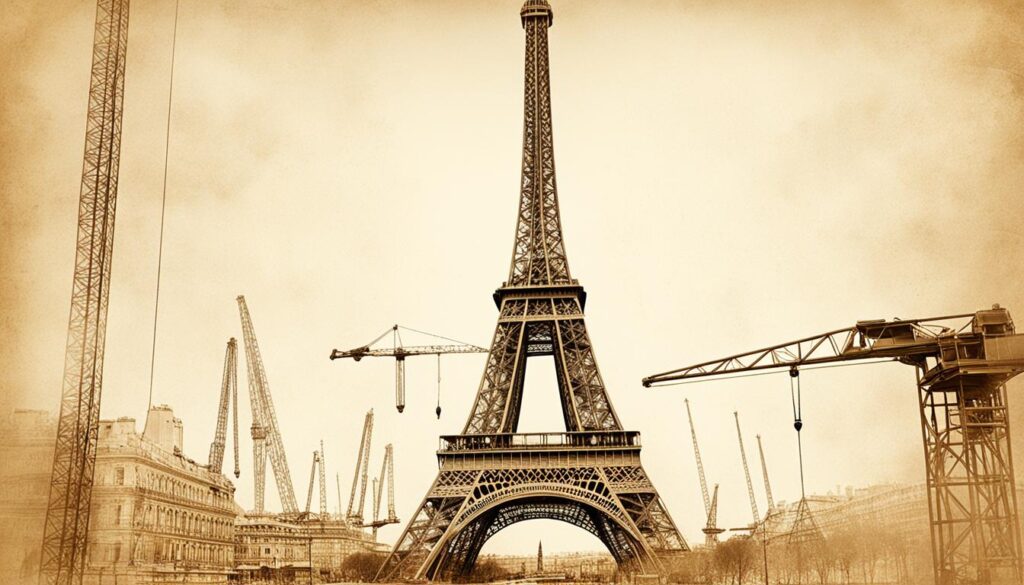The world is full of iconic landmarks that have caught our attention for centuries. The Eiffel Tower and the Taj Mahal are just a few examples. They are symbols of culture and history. But there’s more to these famous places than meets the eye.
Join us as we explore surprising facts and secrets about the world’s most famous landmarks. You’ll learn about their origins, unique designs, and interesting stories. These revelations will change how you see these landmarks.
Prepare to be amazed by the mysteries and histories of these landmarks. From the Eiffel Tower’s secret apartment to the Taj Mahal’s engineering marvels, each has a story. Let’s dive in and uncover the fascinating facts that will change how you view these sites.
Unveiling the Hidden Mysteries of Iconic Sites
Many famous landmarks have hidden rooms and secret passageways. These secrets are not often seen by the public. They give us a peek into the hidden history and design of these places.
The Kremlin in Moscow, Russia, is a great example. Underneath its beautiful palaces and cathedrals, there are underground tunnels and chambers. These were used for things like military defense and moving royalty around. The Statue of Liberty in New York City also has a secret spot. It’s a hidden observation deck that only a few visitors get to see.
The Taj Mahal in Agra, India, is another example. It looks grand on the outside but has hidden rooms under the main building. These were for ceremonies and religious events. They show the detailed planning and design of this famous landmark.
Places like the Kremlin and the Statue of Liberty have many surprises. They have hidden tunnels and special spots that not many know about. By exploring these secrets, we learn more about the stories and designs of these famous landmarks.
Unusual Facts: Uncovering the Unbelievable
Get ready to have your mind blown by strange facts and stories about famous landmarks! We’re going to explore a world full of oddities and surprises. From ancient wonders to modern marvels, you’ll learn about the weird beginnings and hidden secrets of these famous places.
From Ancient Wonders to Modern Marvels
Did you know the Great Pyramid of Giza was once covered in smooth, white limestone? It made it shine like a beacon in the desert. Or that the Eiffel Tower was almost torn down after the 1889 World’s Fair? It was saved and now it’s one of the most famous landmarks in the world.
Landmarks like the Terracotta Army in China and the Burj Khalifa in Dubai have secrets and origins that will surprise you. Get ready for a journey filled with strange facts and stories that will make you see these places in a whole new light.
Exploring the Intriguing History Behind Renowned Landmarks
Many famous landmarks have a rich and surprising history. These sites tell stories that show their cultural importance, how they were built, and the events that shaped them. Let’s explore the tales that have made these landmarks symbols of human creativity and success.
The Eiffel Tower is a symbol known worldwide. When it was built for the 1889 World’s Fair, many in Paris didn’t like it. They saw it as a “giant smokestack.” But it became a symbol of French pride and architectural skill.
The Statue of Liberty is a symbol of freedom and democracy, given to the U.S. by France. It was created in the late 19th century, a time of great change in the U.S. The designer, Frédéric Auguste Bartholdi, saw it as a symbol of the U.S. Constitution’s liberties. It continues to inspire people from all over.

The stories behind famous landmarks are often fascinating. The Taj Mahal, a beautiful white marble mausoleum in India, was made by the Mughal emperor Shah Jahan. It took over 20 years to finish and is now a symbol of love and beauty worldwide.
Architectural Secrets: Designs that Defy Expectations
The world’s most iconic landmarks are more than just beautiful sights. They are architectural wonders that challenge what’s possible with design and engineering. The Zhangjiajie Glass Bridge and the Pantheon show how human creativity can shape the world.
Innovative Engineering Feats Unveiled
The Eiffel Tower is a symbol of French pride and a marvel of design and engineering. Its lattice of iron beams looks like it’s floating in the air. This makes it seem like it’s defying gravity.
The Sydney Opera House is another amazing structure. It looks like white shells floating on the water. Danish architect Jørn Utzon designed it with a complex system of concrete segments. This makes the building stand out as a true architectural achievement.
These landmarks show the amazing work in architectural design and engineering. By looking into their secrets, we learn more about human creativity and the power of design.
Cultural Significance: Landmarks as Symbols of Heritage
Iconic landmarks around the world have become symbols of cultural heritage and national identity. They are woven into the fabric of communities, showing the rich history and creativity of humans.
The Statue of Liberty in New York Harbor is a symbol of freedom and democracy. It shows the dreams of people coming to the United States for a better life. The Taj Mahal in India is more than a beautiful building; it’s a symbol of love and the legacy of the Mughal Empire.
The Parthenon in Greece and the Burj Khalifa in Dubai remind us of the history and culture of their places. They make us feel connected to the human experience, beyond time and space.
By keeping these landmarks safe, we keep their stories alive for future generations. These landmarks show the strength, creativity, and shared values that connect us worldwide.
Bizarre Legends and Myths Surrounding Famous Sites
The world’s most iconic landmarks have legendary tales and mythical stories. These landmark legends and mythical stories have captivated people for centuries. They often mix fact and fiction, making history more intriguing.
Separating Fact from Fiction
Fact-checking famous historical myths is both fascinating and challenging. Consider the “Curse of the Pharaohs.” It says disturbing ancient Egyptian tombs leads to bad luck and death. Yet, many scholars believe this is more myth than fact, based on limited evidence.
Edinburgh Castle in Scotland has its own haunting tales. Visitors have heard about a headless drummer, a green lady, and a ghost child. But, most of these stories come from historical events or creative tales, not real ghosts.
Looking into the mythical stories around famous landmarks shows how hard it is to tell fact from fiction. By digging into these stories, we learn about the sites’ true history and the stories that have shaped them.

Unexpected Purposes: Landmarks with Surprising Functions
The world’s most iconic landmarks have stories that surprise us. Many have been used for more than their original purpose. These sites show how creative and adaptable humans can be. Let’s explore the hidden stories and surprising uses of these landmarks.
The Eiffel Tower in Paris was made for the 1889 World’s Fair but became a symbol of French pride. During World War II, it was used as a secret radio transmitter. This helped the French Resistance fight against the Nazis.
The Statue of Liberty is known as a symbol of freedom and democracy. But, it was also thought to be a possible lighthouse. Gustave Eiffel, the tower’s designer, wanted to use the statue as a giant lighthouse. This idea didn’t happen, but it shows the creative thinking behind these landmarks.
The Colosseum in Rome was more than just a place for gladiator fights. It was also a marketplace and a Christian sanctuary. The Hoover Dam was even used as a nuclear fallout shelter during the Cold War. These landmarks have been repurposed in ways we never expected.
These hidden stories make us see these landmarks in a new light. They inspire us to look beyond what’s obvious and find the extraordinary in everyday things.
Nature’s Wonders: Breathtaking Natural Landmarks
Many of the world’s famous landmarks are made by humans. But, there are also stunning natural wonders that amaze people everywhere. From the tall cliffs of the Grand Canyon to the beautiful ice caves of Vatnajökull National Park, these natural landmarks show the power and beauty of nature.
Marvels Carved by Time and Elements
Nature’s forces have shaped these geological wonders over thousands of years. The erosion formations and natural marvels show how wind, water, and ice change the land. From the amazing rock formations of Arches National Park to the magical ice caves of Vatnajökull National Park, these places remind us of the beauty and strength of our planet.
The geological wonders around the world are not just beautiful. They also tell us about the Earth’s ancient past. From the layered rocks of the Grand Canyon to the strange lava formations of Yellowstone National Park, these natural landmarks let us see the planet’s history.
When you see the tall spires of Monument Valley or explore the mysterious ice caves of Vatnajökull National Park, you’ll be amazed. The natural marvels of our world always inspire and capture our hearts. These natural landmarks, made by nature over thousands of years, show the incredible power and beauty of our planet.
Accidental Discoveries: Landmarks Found by Chance
Some of the world’s most captivating landmarks were found by accident. Their existence was unknown until chance or unexpected explorations revealed them to the world. The ancient city of Petra was rediscovered in the early 19th century. The underwater ruins of Pavlopetri, hidden for centuries, amaze us still.
The lost city of Petra, in modern-day Jordan, was hidden for centuries. Swiss explorer Johann Ludwig Burckhardt found it in 1812. His chance meeting with Bedouin guides led him to the stunning rose-colored rock formations. This discovery changed how we see the region’s history.
The submerged ruins of Pavlopetri, off the coast of Greece, were a secret for millennia. Maritime archaeologists found this well-preserved Bronze Age settlement in the 1960s. These discoveries show us that hidden wonders are still out there. They wait to capture our imaginations and change our view of the past.






